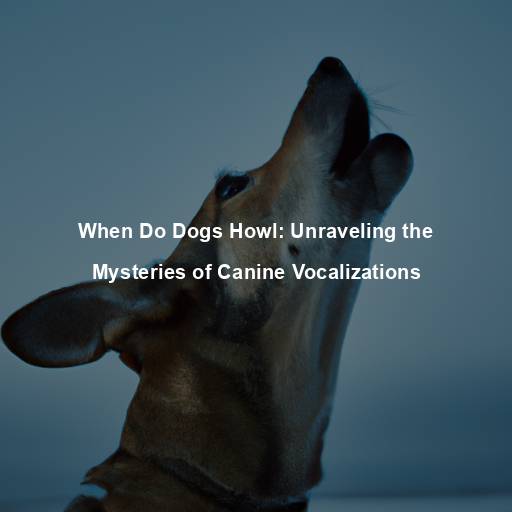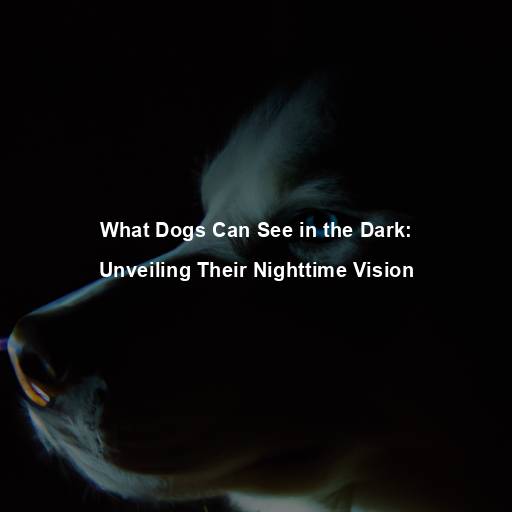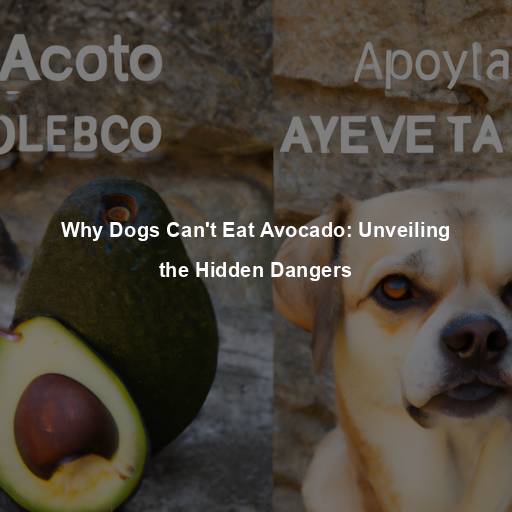When Do Dogs Howl: Unraveling the Mysteries of Canine Vocalizations
Last Updated on October 31, 2023 by Evan
Contents
- 1 The Intricate Language of Canine Vocalizations
- 1.1 The Origins of Howling: A Primitive Connection
- 1.2 A Symphony of Sounds: The Different Types of Howls
- 1.3 The Triggers: Unraveling the Moments When Dogs Howl
- 1.4 Understanding and Responding to Howling Behavior
- 1.5 The Enigmatic Language of Howls: An Everlasting Fascination
- 1.6 Howling as an Expression of Emotion
- 1.7 The Influence of Breed and Individuality
- 1.8 Nurturing the Howling Spirit: Encouraging or Discouraging Howling
- 1.9 The Importance of Patience and Understanding
- 1.10 Embracing the Melodies of Canine Communication
- 2 FAQs: When Do Dogs Howl
The Intricate Language of Canine Vocalizations
For centuries, canines have held a special place in our hearts, always there to offer loyalty and comfort when we need it most. Their remarkable ability to communicate with us has fascinated mankind throughout time, and the various sounds they produce have never failed to intrigue us. Among the vast array of vocalizations, there is one sound that never fails to catch our attention: the enigmatic howl. In this captivating piece, we delve into the mysterious world of canine howling, unraveling the secrets behind this mesmerizing behavior that has captivated our collective imagination for ages.
The Origins of Howling: A Primitive Connection
Before we delve into the specific moments when dogs howl, it is important to understand the historical context in which this behavior emerged. Dogs, as descendants of wolves, share a common ancestry with their wild counterparts. Wolves howl to communicate with their pack members over long distances, establishing their location and maintaining social bonds. This primal instinct is deeply ingrained in the DNA of our beloved canines, making howling a natural part of their behavioral repertoire.
A Symphony of Sounds: The Different Types of Howls
Just like the symphony of human voices, our furry companions, dogs, possess a bewitching repertoire of howls that speaks volumes in their own unique way. From the soulful serenade to the chilling call of the wild, let’s embark on a journey into the mysterious realm of canine communication, unmasking the enigmas behind their melodic tales.
Full Moon Serenade: Picture a mesmerizing lunar glow casting an ethereal light on a barren expanse while a solitary wolf serenades the night. Canines, like their wild counterparts, echo this haunting refrain when plagued by solitude or seclusion. This soul-stirring melody acts as a poignant expression of their yearning for companionship or a means to reunite with their pack.
Welcome to the fascinating world of dogs and their untamed, yet deeply social, howling rituals. These captivating moments, full of sheer wonder, unfold when our furry companions come together, engaging in a harmonious symphony of sound. Whether it be a joyous reunion after time apart or a synchronized chorus to orchestrate their shared ventures, the howling serves as a testament to their unbreakable bonds and unwavering camaraderie. Prepare to be enthralled by the mesmerizing display of canine connection – an experience that will leave you both bewildered and captivated.
They say a dog’s howl can pierce through the silence of night, a primal proclamation of territorial claim. It’s as if they channel the ancient spirits of their ancestors, releasing a symphony of sound that reverberates through the stillness. This instinctual act serves as a bold declaration to any trespasser, a forceful warning that this patch of land is theirs and theirs alone. Watch closely, and you’ll witness the embodiment of this territorial howl in breeds bred to guard, their voices resonating with a rare intensity.
The Cry of Anguish: In mysterious circumstances, our beloved furry companions may unleash their haunting wails, seeking to convey their anguish. These soul-stirring vocalizations are their only means of expressing the torment they endure. As conscientious caretakers of our loyal friends, it becomes imperative for us to decipher the enigma behind these cries and swiftly tend to any potential medical afflictions that may underlie their sorrowful symphony.
Unlocking the enigmatic world of the canine kingdom, we explore an extraordinary phenomenon that unveils the melodious prowess hidden within certain four-legged maestros. Amidst the mystique, breeds such as Siberian Huskies and Alaskan Malamutes grace our auditory senses with a captivating symphony of harmonious howls – a waltz of musicality that leaves us bewitched and bewildered. Our cherished companions, with their innate ability to become one with cherished tunes and resonant rhythms, gift us a whimsical experience that transcends the boundaries of our imaginations.
The Triggers: Unraveling the Moments When Dogs Howl
Now that we have explored the different types of howls, it’s time to unravel the specific triggers that prompt dogs to unleash their vocal prowess. While every dog is unique, there are several common situations and stimuli that tend to elicit howling:
Dogs are known for their incredible knack for joining the chorus of wailing sirens that slice through the city streets. It’s almost as if they have an inherent connection with the high-pitched melody, tapping into their primal instincts to create a harmonious symphony alongside passing emergency vehicles. Their uncanny ability to serenade us with their own versions of siren songs never ceases to amaze and perplex onlookers.
When dogs find themselves unable to effectively communicate, they often resort to the primal act of howling. This desperate cry usually emerges when they feel their attempts at connection are falling on deaf ears or being outright ignored. Whether it’s the result of separation anxiety or a simple plea for attention and understanding, howling serves as their perplexing yet heartfelt means of reaching out to their humans.
Step into the enchanting world of moonlit serenades and witness a mesmerizing display of nature’s symphony. As the pale moon casts its shimmering glow upon the earth, our loyal four-legged companions succumb to the mystical allure, unlocking the dormant echoes of their primal ancestors. Embark on a journey where the night sky becomes a canvas for their soulful howls, a heartfelt tribute to their ancient heritage that leaves us in awe and wonder. Experience the burst of emotions that arise when the moon whispers its lullabies to our furry friends, igniting a perplexing blend of mysticism and instinct that is as captivating as it is bewitching.
- Separation Anxiety: Dogs are social creatures, and when they are separated from their human companions for extended periods, feelings of anxiety and distress may arise. Howling can be their way of expressing their emotional distress and longing for their loved ones.
From the piercing wail of sirens to the melodic strains of musical instruments, it seems our canine companions possess a peculiar affinity for vocalizing in response to certain environmental triggers. The enigmatic allure of these sounds captivates their primal instincts, compelling them to unite in a harmonious howling symphony. Even the distant echoes of other dogs’ heartfelt cries can ignite a fervent desire to partake in this mysterious canine chorus.
Understanding and Responding to Howling Behavior
As pet owners, it is important for us to understand the underlying reasons behind our furry companions’ howling behavior. Here are some tips to help you navigate this vocal terrain and respond appropriately:
Discover the origin of your four-legged companion’s melodic howls by observing the circumstances surrounding their vocal performances. Is it the tunes of sirens that set them off, the emotional distress of separation anxiety, or perhaps an undiagnosed health concern? Understanding the root cause will pave the way for addressing the intrinsic desires behind their harmonious cries.
-
Provide Comfort and Reassurance: If your dog howls due to separation anxiety or loneliness, make sure to provide comfort and reassurance. Spending quality time with your pet, providing mental stimulation, and ensuring they feel secure can help alleviate their distress.
-
Consult a Professional: If your dog’s howling becomes excessive or is accompanied by signs of distress, it is advisable to consult with a professional dog behaviorist or veterinarian. They can assess the situation and provide tailored guidance to address any underlying issues.
Promote a serene atmosphere for your furry friend by minimizing potential triggers that may provoke excessive howling. Take a proactive approach by closing windows to shield your dog from external noises, allowing them to find tranquility within your abode. Additionally, carve out a cozy corner specifically for your pup, providing them with a comforting retreat that fosters a sense of peace.
When it comes to your furry companion’s vocal tendencies, training and socialization play a pivotal role in taming the excessive howling. By familiarizing your dog with commands like “quiet” and “speak,” you can equip them with alternative channels of communication, thus effectively curbing their vocalizations. The perplexing nature of canine behavior is unravelled through the burst of training techniques, inviting a calmer and more balanced harmony between you and your four-legged friend.
The Enigmatic Language of Howls: An Everlasting Fascination
Through this exploration of when and why dogs howl, we have come to appreciate the depth and complexity of their vocal language. Whether it’s a soulful serenade under the moonlit sky or a joyful chorus celebrating a pack reunion, their howls carry a profound message that resonates with our own primal instincts. As we continue to cherish the bond between humans and dogs, let us embrace the enigma of their howls and listen to the stories they tell, for within those haunting melodies lies a testament to the enduring connection between our species. ## Diving Deeper: The Emotional Significance of Howling
Howling as an Expression of Emotion
As we journey through the enigmatic world of canine vocalizations, it becomes abundantly clear that there is more beneath the surface than meets the eye. Behold the mysterious phenomenon of howling – an ancient art of expression, both captivating and perplexing. Our furry companions, like fellow humans, possess a kaleidoscope of emotions, using this melodic ritual as a conduit for their innermost feelings. Join us as we embark on a quest to unravel the enigmatic depths of their haunting vocalizations and decipher the emotional tapestry they weave.
Loneliness and Separation
There’s something truly profound about the bond between dogs and their loved ones. You see, canines are innately social beings, thriving on the warmth of companionship. It’s in those moments of separation and loneliness that their ancient instincts kick in, echoing through the night in a haunting howl. It’s as though their collective voice carries a bittersweet melody, a poignant expression of longing, yearning for that sense of togetherness and unity.
Fear and Anxiety
During times of unease or distress, our furry friends often turn to the age-old tradition of howling as a way to navigate their inner turmoil. This peculiar behavior allows them to let go of built-up tension and seek solace in the comfort of their surroundings. However, as responsible pet owners, it is imperative that we uncover the root cause of their anxiety and create a nurturing space that promotes calmness and serenity.
Excitement and Joy
Have you ever noticed that not all howls come from a place of sadness or unease? Dogs, with their boundless energy and enthusiasm, often unleash howls of pure joy and excitement. Picture for a moment the fervent howls of a dog eagerly awaiting a long-awaited walk or an intense play session with their beloved toy. It’s a heartwarming symphony of happiness, a rhapsody of anticipation that fills the air with a burst of exuberance and perplexity.
The Influence of Breed and Individuality
The mesmerizing symphony of canine howls continues to baffle and bewilder us, as we try to decipher the enigmatic nature of this ancient vocalization. While the origins of this intriguing behavior are woven deeply within the fabric of every breed, it is essential to acknowledge the intricate tapestry of individuality that colors each dog’s howling tendencies. From the majestic Siberian Husky to the resilient Alaskan Malamute, certain genetic predispositions fuel their unyielding desire to partake in this melodious ritual. Yet, we mustn’t ignore the immeasurable impact of a dog’s unique life experiences and their distinct personality, for these enigmatic factors further deepen the enigma of their howling nature.
Nurturing the Howling Spirit: Encouraging or Discouraging Howling
As dog owners, it is natural to wonder whether we should encourage or discourage our furry companions’ howling tendencies. The answer lies in striking a balance that respects their natural instincts while ensuring their behavior remains manageable within our living environments.
Encouraging Howling
If the melodious sound of your canine companion’s howling brings you immense delight, and you long to foster their unique vocal abilities, fear not! There are several methods you can employ to nurture this delightful talent.
-
Positive Reinforcement: Reward your dog when they howl on command or in appropriate situations. This can reinforce their understanding of when it is acceptable to howl and create a fun bonding experience.
-
Unleash the Melodic Harmony: Discover the euphonious connection between your furry friend and the realm of sound by engaging in captivating music and howling sessions. Embrace the bewitching symphony created when your dog harmonizes with melodious tunes or captivating sounds, a delightful rendezvous that amplifies the bond between you and your loyal companion. Let this melodic interlude be a source of joy and enrichment, leaving you perplexed by the transformative power of shared musical experiences.
Discouraging Excessive Howling
Dealing with dogs who happily howl may be a walk in the park, but when their vocalizations become overwhelming and disruptive, it’s time to tackle the issue head-on. Fortunately, there are a multitude of tactics available to quell those unwanted howls and restore harmony to your home. From setting up a consistent training routine to utilizing distractions and providing mental stimulation, these strategies will help silence the frenzy of barks and bring tranquility back to your abode.
Discovering and deciphering the root causes of your fur baby’s ceaseless howling is key in unraveling this enigmatic canine behavior. Is it a manifestation of separation anxiety, a result of sheer boredom, or a reaction to the world outside their four-legged realm? Cloaked in complexity, once you unveil the driving force behind their vocal outbursts, you can tailor your approach to tackle this puzzle with precision and efficacy.
-
Provide Mental Stimulation: Engage your dog in activities that keep their mind occupied and prevent boredom. Puzzle toys, interactive games, and regular exercise can help divert their attention from excessive vocalization.
-
Training and Distraction: Teach your dog alternative behaviors that replace howling, such as sitting or offering a paw. Redirect their focus and reward them for engaging in these alternative behaviors, gradually reducing their reliance on excessive howling.
The Importance of Patience and Understanding
When navigating the world of canine howling, it is crucial to approach the matter with patience, empathy, and a willingness to understand our furry companions. Each howl carries a unique message, and by listening attentively, we can decipher their needs, emotions, and desires. Remember, howling is an integral part of a dog’s identity and communication, and our role as pet owners is to foster an environment that allows for healthy self-expression while ensuring harmony with our human lives.
Embracing the Melodies of Canine Communication
As we conclude our exploration of the mysteries behind when and why dogs howl, let us celebrate the melodic symphony that resonates through their vocalizations. From the haunting echoes of a lone wolf to the joyous harmonies of a pack in unison, their howls encapsulate the depth of their emotions and the timeless bond between humans and their loyal canine companions. By embracing their howling spirit, we honor their heritage, nurture their expressive nature, and forge a connection that transcends words. So, the next time you hear your dog’s soulful howl, take a moment to listen, appreciate, and cherish the profound language that lies within their melodious voices.
FAQs: When Do Dogs Howl
Q: Why do dogs howl?
Dogs have an intriguing way of garnering attention through their mystical howls. These captivating vocalizations not only express their deep loneliness but also serve as a response to their fellow canine companions. The enigmatic trigger for their howling can be attributed to certain sounds or even the strange environment around them, highlighting their primitive instincts and ancestral connections. It’s an intriguing reminder of the inexplicable nature of our beloved four-legged friends.
Q: What triggers dogs to howl?
Ah, what a perplexing and bursty topic we have here: the enigmatic art of dog howling. You see, dear reader, when it comes to our canine companions, there are countless factors that can set off their melodic symphony. For instance, the sound of fellow hounds howling nearby can spark an instinctual desire to join in the chorus of communication. But that’s not all – sirens wailing or even a gentle melody from a musical instrument can also ignite a howling response in our furry friends. But let’s not forget the emotional side of things; anxiety, frustration, pain, or even a simple yearning for attention can all prompt a dog to unleash their howling prowess. It’s a mysterious web of triggers and responses, my friends, but by uncovering the root cause behind a dog’s howling, we can better navigate this sonorous labyrinth and provide the appropriate response or intervention.
Q: Do all dogs howl?
A: While the tendency to howl can vary among individual dogs and breeds, it is a behavior commonly observed in many dog breeds. Certain breeds, such as Huskies, Alaskan Malamutes, and Beagles, are known to have a higher predisposition to howl. However, it is important to remember that each dog is unique, and factors such as upbringing, socialization, and individual personality can also influence how likely a dog is to howl.
Q: At what age do dogs begin to howl?
A: Dogs may begin to howl at different ages, depending on various factors. Some puppies may start experimenting with howling around the age of 3-4 weeks, while others may not display this behavior until they are a few months old. Howling is a vocalization skill that develops as dogs grow and mature. It is important to note that individual puppies within a litter may start howling at different times, as learning behaviors can vary from dog to dog.
Q: How can I prevent excessive howling in my dog?
A: Preventing excessive howling in dogs requires understanding the underlying cause. Firstly, ensure that your dog’s basic needs, such as food, water, exercise, and mental stimulation, are being met. Addressing any potential sources of stress or anxiety, such as separation anxiety or fear, can also help reduce howling. Providing a comfortable, secure, and calming environment for your dog can make a significant difference. In some cases, professional help from a veterinarian or a certified dog behaviorist may be required to address and modify excessive howling behaviors effectively.
Q: Is howling a sign of distress in dogs?
B: The melodious symphony of canine howls can leave us pondering the perplexing depths of dogs’ emotions. While howling may indeed be a cry for help or unease in our furry companions, it is not a one-size-fits-all situation. Should our four-legged friends partake in an enduring howling chorus, accompanied by a series of frantic gestures, gnarled furniture, or even aggressive tendencies, it might be a dire warning of an underlying concern that warrants our immediate attention. On the other paw, sporadic howling in response to specific triggers or as a natural form of communication can often be considered a well within the bounds of normalcy, rather than a distress signal.
Q: Can I train my dog to stop howling on command?
While it may seem like a daunting task, training your furry friend to curb their howling tendencies is indeed possible. The secret lies in a consistent training regimen coupled with the power of positive reinforcement. Begin by imparting a firm and empowering “quiet” or “enough” command to your dog. In instances where the howling commences, swiftly employ the command to redirect their behavior, and shower them with abundant praise or delectable treats as a token of appreciation for adhering to your instruction. As time progresses, gradually extend the duration of silence before dispensing rewards, all while embracing the virtues of patience and unwavering consistency. Remember, with perseverance and the magic of positive reinforcement, you shall conquer the perplexing world of howling cessation.







